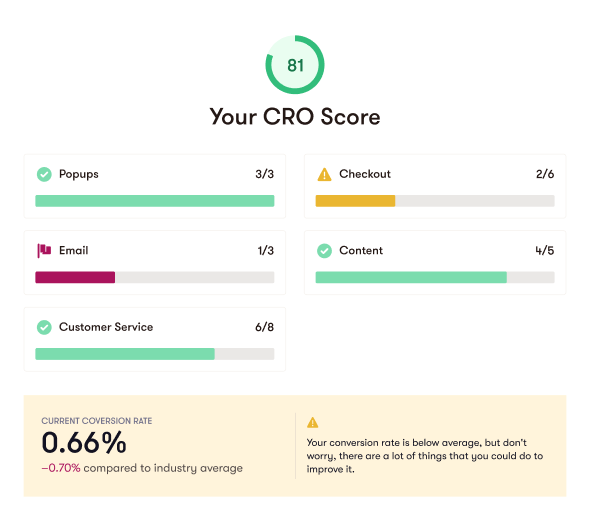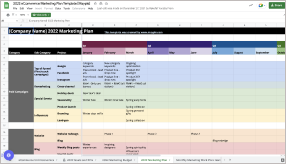
An Essential Guide to Fashion eCommerce: Top Trends and Strategies for 2023
Here are the latest trends in Fashion eCommerce including AI stylists, VR fitting rooms, recommerce, genderless fashion, altheisure, "Buy Now Pay Later".
DOWNLOAD TEMPLATEThe fashion industry is one of the most dynamic industries in the world. It changes with seasons and adapts quickly to shifts in consumer behavior, technology, and market conditions.
The global eCommerce industry may be worth $16 trillion by 2027, thanks to an ever-increasing number of social media and internet users. And fashion brands account for a sizable chunk of all eCommerce sales.
Even at the height of the pandemic, when retail sales hit rock-bottom, the fashion eCommerce industry rose to the challenge. Virtual fitting rooms, convenient delivery, and payment options attracted online shoppers.
As the retail industry continued to recover, apparel and accessories led the way with an annual growth rate of 23.1%. This changing face of fashion eCommerce paved the way for many new trends.
In this post, we explore some of the top marketing trends for eCommerce fashion brands and discuss how they can succeed in 2023.
Let’s dive in.
[Add Banner Here]
eCommerce fashion industry insights
The global online fashion market was worth $752.5 billion in 2020. It makes up the largest segment of the B2C eCommerce market.
In the United States alone, fashion eCommerce constituted 29.5% of all fashion retail sales in 2020. Total revenue from the online sales of apparel, accessories, and footwear stood at $110.6 billion and may reach $153.6 billion by 2024.
Fashion eCommerce is no longer just a combination of online and offline stores. It has evolved to provide integrated shopping experiences across multiple channels. The changing shopping habits and lifestyles during the pandemic have been a major driving force behind this.
Mobile devices account for about 66% of online fashion sales and drive 76% of online traffic today. With fashion shoppers engaging across multiple platforms, brands go the extra mile to offer omnichannel experiences.
Social media influencers are yet another driving force in the fashion eCommerce industry. Platforms like Instagram and popular blogs reach a large audience. That's why social commerce and influencer marketing are some of the most popular marketing strategies used by fashion eCommerce brands today.
The fashion industry’s response to the COVID-19 pandemic
COVID-19 has been the biggest disruption hitting businesses in a very long time. The eCommerce fashion industry too faced some unique challenges. Online shopping increased dramatically and fashion retailers had to shift priorities and focus on digital channels.
Some online retailers thrived during the coronavirus pandemic. A striking example is Shein, the 7-year old fashion company that created a mobile app that shot up to the top of the rankings in the US.

Top strategies for fashion & apparel brands in 2023
1. Sustainability & ethical sourcing
One of the biggest trends we've seen this year is that consumers are leaning toward brands that practice sustainability and ethical sourcing. Fast fashion has long been associated with several human rights violations and negative environmental impacts. So this comes as a breath of fresh air.
Lyst, a shopping search platform recently found that:
- In 2020, “slow fashion” generated 90 million social impressions
- Searches for “vegan leather” increased 69% YoY, and
- Searches for “upcycled fashion” increased 42%
While this trend was already on the rise pre-pandemic, COVID-19 has given the movement new wings. It has increased people’s awareness of social governance and environmental issues. As a result, brands are leaning towards sustainability and ethical sourcing more than ever before.
2. Re-commerce
The fashion industry is largely responsible for the tons of plastic microfibers that enter our oceans. And 4% of global carbon emissions. Every second, one garbage truck equivalent of clothes ends up in landfills or gets burned. This puts tremendous pressure on the environment.

Thankfully, many consumers are now leaning towards reselling, renting, and reusing clothes. Many people turned to thrifting due to the tough economic conditions brought on by COVID. And some made a conscious choice towards sustainability and minimalism.
Because of intense consumerism, second-hand clothing items are often in great condition. In fact, 33 million customers bought used clothes for the first time in 2020.

This trend may stick due to the growing awareness about eco-friendly fashion, minimalism, and the need for a circular economy. As a result, the resale market is gaining momentum and may hit $47 billion by 2025.
3. Virtual AR and VR fitting rooms
A major concern for online shoppers buying apparel has always been: will the products fit me? But amid a raging pandemic, it was next to impossible for them to go to physical stores to find their fit.
Enter AR and VR fitting rooms.
Smart-fitting technologies based on augmented reality/virtual reality use measurements (or typical sizes of other brands) to detect the customer’s contour. AR and VR fitting rooms can give customers an almost life-like view of the style, size, and fit of a particular item.
This allowed apparel retailers to offer unparalleled user experiences even at the height of the pandemic. Customers could try on clothing items virtually by answering a few simple questions from the safety and comfort of their homes.
The virtual fitting room market is expected to reach $6.5 million by 2025 at a compounded annual growth rate of 13.75% and fashion brands that aren't using AR yet need to catch up if they want to continue competing with brick-and-mortar stores.
4. Athleisure
Athleisure combines the best of both worlds: athletics and leisure. The category is growing rapidly as customers seek more casual, active, and comfortable clothing. With athleisure orders increasing by 84% since the pandemic, the global athleisure market may reach $549.41 billion by 2028.
Gym and sportswear have long been seen as stylish, active, and comfortable. These are now made to suit other social settings as well. After all, there’s no reason why you can’t go grocery shopping in those comfy yoga pants!

Athleisure offers tons of choices combining style and functionality — from elastic knots to wide pockets — allowing customers to carry large mobile devices, wallets, and other essentials. The trend started with brands like Lululemon, Athleta, and Nike. But even the likes of Levi’s and Louis Vuitton have been catching up.
5. Genderless fashion means there’s a fit for everyone
“Unisex” has been a buzzword in the fashion industry for a long time. We're seeing this a lot more in fashion as the cultural trends of the day move away from the traditional male and female roles in society.
Lately, as a new cultural development, we’ve been seeing a gradual erosion of gender roles. People seem to believe that gender has to do with how you feel about yourself and not what society has defined it as. And very few things are as inherent to your personality as your style.
48% of Gen Zers (and 38% of other generations) value brands that don’t classify products as “male” or “female” and offer a lot of unisex options.

Genderless fashion is making deep inroads and brands are quickly adapting to the trend. Brands like Vans, Selfridges, Totokaelo, Dion Lee, Telfar, and Saint Sernin are leading the way in genderless fashion. Both fearlessly and aesthetically!
6. Buy now, pay later
As a result of the pandemic, consumers have become more cautious about impulsive shopping and spells bad news for sectors like fashion eCommerce. Thankfully, buy now, pay later options (BNPL) have allowed the shopping to go on.
Brands have partnered with several finance start-ups (Klarna, Affirm, Afterpay) that provide micro-credits with installment options. Most don’t even charge interest as long as customers pay their installments on time.

As a result, brands are seeing more orders from customers who may not be able to afford the full price at one go. This translates to higher average order values, greater sales and better retention rates.
7. Greater reliance on AI recommendations
Artificial Intelligence has left no industry untouched and is taking the fashion industry by storm too. The global spend on AI by retailers will hit $12 billion by 2023.
Brands use AI-based chatbots to resolve customer questions or direct them to the right human agents. Other brands are leveraging AI-based style assistants. These offer personalized style suggestions and product recommendations that positively impact the customer experience.

AI now aids visual search, automatic tagging, fashion trends prediction, and even supply chain management. Soon, AI will play an even bigger role in identifying trending items, analyzing shopping behavior, and optimizing the value chain.
Top Fashion eCommerce Strategies for 2023
There’s very little doubt that the industry is evolving owing to two main forces: trends and technology. Since both are extremely dynamic, brands have very little choice but to adapt. Here’s a look at the most popular marketing strategies that fashion eCommerce sites need to consider to stay competitive this year:
1. Provide a personalized shopping experience
Personalization is no longer optional, especially in fashion eCommerce. And it has to do with the entire customer journey. From the initial ad campaign to the retargeting email, all the way to your product pages and checkout process.
The modern shopper expects the entire journey to be relevant and personalized to their interests. From the “thank you for your purchase” email to the “did you like our products”, every step of the buyer journey should be fully adapted to your customer’s interests and behavior.
Analyzing their purchase history is a good place to start. But it can extend far beyond that. By analyzing their browsing patterns, style preferences, weather, and purchase frequency, you can send them relevant offers, product recommendations, style references, and other useful content.

Brands use Big Data and AI to sort through the enormous amount of data and personalize the experience for each customer. Hyper-personalization allows brands to identify past purchase patterns, consumer behavior, and preferences and then use them to send highly customized content to subscribers and customers via email and SMS.
2. Leverage user-generated content (UGC)
Honest reviews on eCommerce sites help potential customers make informed decisions about purchases. Almost 9 out of 10 consumers check out customer reviews before purchasing any products online.
These reviews become especially powerful if they are posted as an image or video of the customer using your product. This is the closest thing to word-of-mouth marketing in the eCommerce world.
Encourage users to leave reviews on your product pages and share their stories on social media platforms with your branded hashtag. Calvin Kein’s #mycalvins is a great example. It has almost a million mentions on Instagram alone.
3. Highlight what makes your brand unique
Fashion has a lot to do with people’s personalities. What someone wears is a reflection of their self-image. It's how they see themselves or aspire to be seen. That’s why brand personification is a must.
So don’t be afraid to showcase your brand personality or the causes you believe in. Patagonia appeals to the adventurous and outdoorsy. Carhartt represents the hard work and dependability of the working class. And Curvy Kate celebrates curvy women and body positivity.
Establishing the uniqueness of your brand is the first step toward carving out a prominent position for yourself in the market.
4. Use high-quality product photography
In a business driven by optics, high-quality product photos on your website and social media channels are a must. After all, there can’t be anything worse than having top-notch products but not showcasing them accurately online.
Make sure you have high-quality product photos taken from multiple angles on your website. 360-degree images would be even better. Allow customers to zoom in on the finer details of your products and view color options on the website.
Fashion apparel brands like Curvy Kate showcase product photos on different size models for the same item.
5. Leverage social commerce
As we discussed earlier, influencers and social media platforms like Facebook and Instagram significantly amplify a brand’s reach. Engaging customers by showcasing products via Facebook and Instagram Live caught on during the pandemic in a big way.
Both platforms now allow you to set up online shops or storefronts where customers can choose their products, pay online, and get them delivered to their doorstep. Brands need to leverage pictures, videos, stories, and hashtags to drive more traffic to both their online store and various marketplaces.
Here’s an example of a buyable pin on Pinterest.

Want to take advantage of Pinterest’s commerce features? Check out our list of the top Pinterest growth agencies to work with in 2023.
6. Visual search
Create exceptional shopping experiences by allowing customers to search for the right products using multi-dimensional filters. Allowing them to search by price, color, size, etc. makes their shopping experience easy and convenient.
A leading trend we're seeing is brands using visual search - allowing customers to search using images and to see similar images to a given picture.

7. Offer amazing customer service
Customer satisfaction is the secret sauce behind the success of any business. And quality customer service is the key to ensuring that your customers are happy and want to come back again.
Regardless of the platform you use, your service needs to be fast, consistent, and reliable. So focus on building a well-trained and well-equipped customer service team. Invest in automation so that customers can get support even outside of your business hours.
For example, brands like Natori use AI to respond to customers on social media and identify the most relevant content for them.
Also, leverage email marketing to collect feedback, share relevant offers, personalized content, and product recommendations to build a solid base of loyal customers.
To take the customer experience up a notch, create an AI shopping assistant that helps customers pick the best product for them, via Facebook Messenger or using live chat. With virtual styling assistance, you can also provide fashion advice and help customers choose a personalized ensemble online.
Recap
Despite COVID, the fashion industry has shown an incredible ability to bounce back. By making the most of technology and data, brands have reshaped their marketing strategies.
The most successful brands are the ones that kept their eyes on the ball and tracked trends carefully. Use the strategies mentioned above to take your fashion eCommerce store to even greater heights this year.
And as always, if you need any help with your eCommerce strategy this year, reach out and talk to the world's top marketers. We can match you with an experienced, vetted email marketer in your niche -- all in a matter of days, so you can get the ball rolling and maximize your email marketing efforts.















